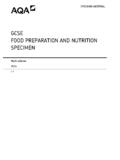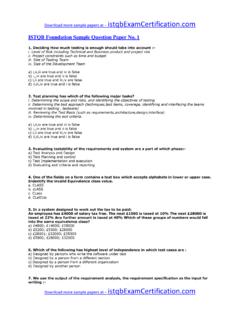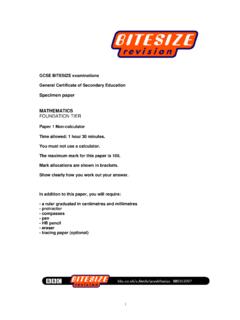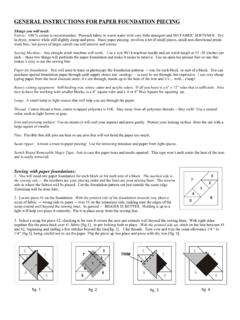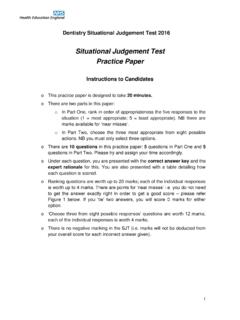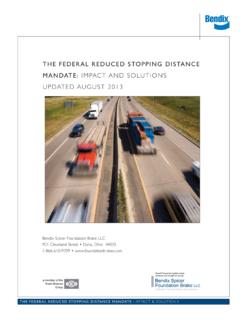Transcription of Foundation Tier Paper 4: Chemistry 2F - …
1 SPECIMEN MATERIAL GCSE COMBINED SCIENCE: TRILOGY Foundation Tier Paper 4: Chemistry 2F Specimen 2018 Time allowed: 1 hour 15 minutes Materials For this Paper you must have: a ruler a calculator the periodic table (enclosed) Instructions Answer all questions in the spaces provided. Do all rough work in this book. Cross through any work you do not want to be marked. Information There are 70 marks available on this Paper . The marks for questions are shown in brackets. You are expected to use a calculator where appropriate. You are reminded of the need for good English and clear presentation in your answers. When answering questions and you need to make sure that your answer: is clear, logical, sensibly structured fully meets the requirements of the question shows that each separate point or step supports the overall answer.
2 Advice In all calculations, show clearly how you work out your answer. Please write clearly, in block capitals. Centre number Candidate number Surname Forename(s) Candidate signature F 2 SPECIMEN MATERIAL 0 1 This question is about gases in the Earth s atmosphere. 0 1 . 1 The amount of carbon dioxide in the Earth s atmosphere decreased during the first billion years of the Earth s existence. Complete the sentences. Use words from the box. [2 marks] carbonates dissolved evaporated melted nitrates sulfates The amount of carbon dioxide in the Earth s atmosphere decreased because the carbon dioxide _____ in the oceans. Sediments were formed when _____ were produced.
3 Algae and plants use carbon dioxide and water to produce oxygen. 0 1 . 2 What is the name of this process? [1 mark] Tick one box. Carbon capture Combustion Photosynthesis Polymerisation 0 1 . 3 Complete the word equation for this process. [1 mark] carbon dioxide + _____ glucose + _____ 3 SPECIMEN MATERIAL Turn over Draw one line from each gas to the approximate percentage of the gas in the Earth s atmosphere today. [3 marks] Carbon dioxide is a greenhouse gas. Why does increasing the amount of carbon dioxide change the global climate? [1 mark] Question 1 continues on the next page 0 1.
4 4 0 1 . 5 4 SPECIMEN MATERIAL How can countries reduce carbon dioxide emissions? [1 mark] Tick one box. only burn methane use renewable energy supplies use waste plastic bags as fuel Give one reason why it is difficult for countries to reduce emissions of carbon dioxide. [1 mark] 0 1 . 7 0 1 . 6 5 SPECIMEN MATERIAL Turn over Turn over for the next question 6 SPECIMEN MATERIAL 0 2 The apparatus in Figure 1 is used to separate a mixture of liquids in a fuel. Figure 1 0 2 . 1 What is apparatus W on Figure 1? [1 mark] Tick one box. Beaker Boiling Tube Flask Jug 7 SPECIMEN MATERIAL Turn over 0 2.
5 2 What is the name of this method of separation? [1 mark] Tick one box. Crystallisation Electrolysis Filtration Distillation 0 2 . 3 Name the changes of state taking place at A and B in Figure 1. Use words from the box. [2 marks] Change of state at A: _____ Change of state at B: _____ Question 2 continues on the next page boiling condensing freezing melting 8 SPECIMEN MATERIAL Table 1 shows the boiling points of the hydrocarbons in the fuel. Table 1 Hydrocarbon Boiling point in C Pentane 36 Hexane 69 Heptane 98 Octane 125 0 2 . 4 Which hydrocarbon will be the last to collect in the beaker?
6 [1 mark] Tick one box. Pentane Hexane Heptane Octane 0 2 . 5 The fuel is a mixture of liquids that has been designed as a useful product. What name is given to this type of mixture? [1 mark] Tick one box. Catalyst Formulation Polymer Solvent 9 SPECIMEN MATERIAL Turn over 0 2 . 6 Describe how this fuel is different from crude oil. [2 marks] 0 2 . 7 A student measured the melting point of a solid hydrocarbon four times. The student s results are in Table 2. Table 2 Trial 1 Trial 2 Trial 3 Trial 4 Melting point in C 35 48 37 37 Calculate the mean melting point of the hydrocarbon, leaving out any anomalous result.
7 Give your answer to two significant figures. [2 marks] Mean melting point = oC Turn over for the next question 10 SPECIMEN MATERIAL 0 3 This question is about drinking water. Name two methods of treating water from rivers, lakes or the sea to produce drinking water. [2 marks] Tick two boxes. Anaerobic digestion Cracking Desalination Electrolysis Sterilising Table 3 shows the amounts of dissolved ions in a sample of drinking water. Table 3 Dissolved ion Mass in mg per dm3 Cl 250 Na+ 200 NO3 40 What is the name of the ion with the symbol Cl ?
8 [1 mark] Tick one box. Calcium ion Carbonate ion Chloride ion Chlorine ion 0 3 . 1 0 3 . 2 11 SPECIMEN MATERIAL Turn over Use the information in Table 3 to complete the bar chart in Figure 2. [1 mark] Figure 2 Question 3 continues on the next page 0 3 . 3 12 SPECIMEN MATERIAL Look at the questions labelled A, B, C, D. A How many substances are there in drinking water? B How much fluoride is in drinking water? C Is fluoride soluble in drinking water? D Should fluoride be added to drinking water? Give two reasons why the answer you have chosen cannot be answered by science alone. [2 marks] 1 2 0 3 . 4 Which one of the questions cannot be answered by science alone?
9 [1 mark] Tick one box. A B C D 0 3 . 5 13 SPECIMEN MATERIAL Turn over A sample of drinking water contains mg of fluoride per dm3 of water. A person drinks 1 dm3 of this water. The recommended daily amount of fluoride is mg. Which calculation gives the percentage of the recommended daily amount of fluoride in 1 dm3 of this water? [1 mark] Tick one box. 100 100 100 100 Question 3 continues on the next page 0 3 . 6 14 SPECIMEN MATERIAL Figure 3 shows the effect of fluoride in drinking water on tooth decay in different age groups. Figure 3 Describe the pattern of tooth decay in Figure 3 for water without fluoride.
10 Use data to justify your answer. [2 marks] Describe the effect of adding fluoride to drinking water for the age groups in Figure 3. [2 marks] 0 3 . 7 0 3 . 8 15 SPECIMEN MATERIAL Turn over 0 4 A student investigated the substances produced when fuels burn. Figure 4 shows the apparatus the student used. Figure 4 The complete combustion of a hydrocarbon produces carbon dioxide and one other substance. Look at Figure 4. What would the student see in tube A? [1 mark] When the student burned the fuel she saw soot in the funnel. Explain why soot forms. [2 marks] Question 4 continues on the next page 0 4 . 2 0 4 . 1 16 SPECIMEN MATERIAL The student burned another fuel which contained impurities.









